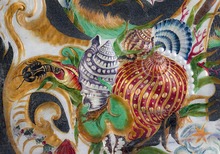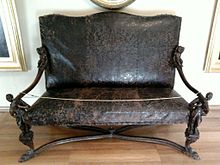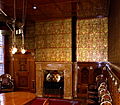Leather wallpaper



Leather wallpaperis a type ofwallpaperused in various styles for wall covering. It is often referred to aswrought leather.[1]It is oftengilded,painted and decorated. Leather was used to cover and decorate sections of walls in the houses of the rich, and some public buildings. Leather is pliable and could be decorated in various ways.
Cuir de Cordoue,orcordwainorcordovan(meaning: "fromCórdoba"), sometimes calledgold leather(from Dutch "goudleer" ), refers to painted andgilded(and oftenem Boss ed) leather hangings, manufactured in panels and assembled for covering walls as an alternative totapestry.These terms are mostly used for historical and antique materials.
History
[edit]Cuir de Cordoue originated from North Africa and was introduced toSpainas early as the ninth century. In Spain such em Boss ed leather hangings were known asguadamecí,from theLibyantown ofGhadames,whilecordobanes( "cordovan") signified soft goat leather.[2]In 1316, a Cuir de Cordoueguildexisted inBarcelona.Spanish gold leather was popular until the early seventeenth century.
In the fifteenth or sixteenth century, the technique reached theLow Countries,first inFlandersandBrabant,where it was further developed. Though there werecraftsmenin several cities (such asAntwerp,Brussels,andGhent), the majorhandicraftcenter for gold leather wasMechelen,where it was mentioned as early as 1504. In theDutch Republicgold leather-making flourished in the seventeenth century inAmsterdam,The HagueandMiddelburg.In Amsterdam, at least eleven gold leather-makers were active. One of them, Hans le Maire, because of the smell, the need for water, wind and light, working at the edge of the city[3]or inVreeland,[4]used up to 16,000 hides of calves and some 170,000 leaves of silver annually.[5]
Dutch Cuir de Cordoue was exported toGermany,Denmark,Sweden,ChinaandJapan.The last Amsterdam gold leather merchant Willem van den Heuvel closed around 1680, but the trade and production continued in Flanders and Northern France.
With the advent of printedwallpaperfrom about 1650, often imported from China as well as made in Europe, the far more expensive leather wallcoverings began to decline, though they continued to be used, in a rather revivalist sprit, in very luxurious homes.
Em Boss edwall coverings made to imitate antique em Boss ed leather includeTynecastle,orModeled Canvas.It was developed and patented in 1874 by designerW. Scott Morton(1840–1903). It was made by hand pressing canvas into carved wooden molds and dry it. It was colored after it was stuck to the wall.[6]
Japanese Leather Paperimitates em Boss ed leather. It is crafted from sheets of handmade paper pressed together. It is then em Boss ed and gilded with the field color stenciled on it. A coat oflacquerwas added to protect it and create a sheen.[6]
During the colonial period in the United States, em Boss ed leather panels were occasionally used as an accent, as adado,on a screen, or above achimney.[7]In the last quarter of the 19th century, leather panels were revived and used in select rooms of mansions such as libraries. Introduced in the 1860s as "oil leather papers", the coverings later became known as "leather paper" and were offered in catalogs fromPaul Balinin Paris'BirgeinBuffalo, New York;andJeffrey & Co.andWoollams & Co.They included em Boss ing, gild and painted finishes designed to imitate leather wallpaper and were used to line furniture and cabinets. Their use continued in fancy homes of the late 19th and early 20th century decorating[7]LincrustaandAnaglyptawere competing products. Leather papers were often made up of a series of paper laminates which were forced into shape with a mold, while Lincrusta is a patented composite material, and Anaglypta is a simthat were not designed to look like leather wallpaper.Rottman, Strome & Co.became a major producer based in England with manufacturing in Japan.Lutson Goudledermade the imitation leather coverings in southern France and they were also made in Poland.[7]
Technique
[edit]Cuir de Cordoba was usually made of fine leather; often calf skins were used. The technique consisted of shaping panels of wet leather over wooden moulds, then painting them, then oil-gilding and lacquering them. Sometimes smooth panels of painted Cuir de Cordoue were used.
Patterns for these panels followed fashions insilk damask,at some lag in time, since the high-relief wooden moulds were laborious to make. After the second half of the 18th century, this luxuriousartisanproduct was no longer made,[8]its place taken in part bychintzhangings and printedwallpapers.In the eighteenth centuryChinoiseriepatterns were popular with Cuir de Cordoue.
Use
[edit]Structures with leather wallpaper include:
- Chatsworth House
- Dyrham Park
- Ginter House
- Ham House,near London
- Djursholm Castle
- ThePeacock Room,using early 16th-century leather brought to England byCatherine of Aragon,then reconstructed in London in the 1890s, now in theFrick Collectionin New York.
- Isabella Stewart Gardner MuseumofBoston,Massachusetts
- Loreto Abbey atRathfarnham
- Ehreshoven Castle
- Town Hall of Bremen(Cuir de Cordoue)
- Oranienbaum Palace
- Moritzburg Castle(painted leather wallpaper)
- Metlife Insurance Company Buildingboardroom
Important examples of Cuir de Cordoue can be seen in theNetherlandsin theRijksmuseum Amsterdam,theStedelijk Museum De Lakenhaland a side chamber of thePieterskerk,both inLeiden,the Museum Van Gijn inDordrecht,theMaastrichttown hall and theDrents MuseuminAssen.InBelgiumfine examples can be seen inMuseum Plantin-MoretusinAntwerp,Museum Hof van Busleyden inMechelenand Malonne Abbey (nearNamur). In Germany examples ofLedertapetecan be found in theTown Hall of BremenandMoritzburg Castle(nearDresden). In Scandinavia Cuir de Cordoue can be seen inRosenholm Castle(Denmark) andSkokloster Castle(Sweden). Baroque State Rooms of theWawel Castlein Kraków (Poland) were covered with an early 18th-century cordovan from kingAugustus III's castle atMoritzburg.[9]
-
Hof van Busleyden,Mechelen
-
Town hall ofBremen
-
Antependiumin the church ofAlloue
-
Skokloster Castle,17th century
See also
[edit]References
[edit]- ^Wrought Leather;as a medium of decoration by Helen Henderso] House & Garden, Volume 4 page 227
- ^John Waterer,Spanish Leather(Faber & Faber, London, 1971), outlines the history of this technique
- ^Abrahamse, J. E.De grote uitleg van Amsterdam: stadsontwikkeling in de zeventiende eeuw.p. 217.
- ^Het Goudleerhuis te Vreeland[permanent dead link]
- ^http://research.frick.org/montias/browserecord2.php?-action=browse&-recid=1746Archived2014-11-29 at theWayback Machine[deadlink]
- ^ab"1870–1890 Profusion of Patterns—Historic New England".Archived fromthe originalon 2014-02-07.Retrieved2014-02-07.
- ^abcLeatherWallpaper Scholar
- ^"Atlas of World Art".Profkoslow.
- ^"State Rooms".wawel.krakow.pl.Retrieved2013-05-13.
Further reading
[edit]- Koldeweij, Eloy (2000). "Gilt Leather Hangings in Chinoiserie and Other Styles: An English Speciality".Furniture History.36:61–101.JSTOR23409993.
- Historical wall coverings and wallpaper restorationby Paul Bramley, ISS Institute/Tafe Fellowship[dead link]


![Hof van Busleyden [nl], Mechelen](https://upload.wikimedia.org/wikipedia/commons/thumb/c/c5/Goudleer_in_Hof_van_Busleyden.jpg/96px-Goudleer_in_Hof_van_Busleyden.jpg)
![Malonne Abbey [nl]](https://upload.wikimedia.org/wikipedia/commons/thumb/2/2b/Malonne_goldleather.jpg/120px-Malonne_goldleather.jpg)



